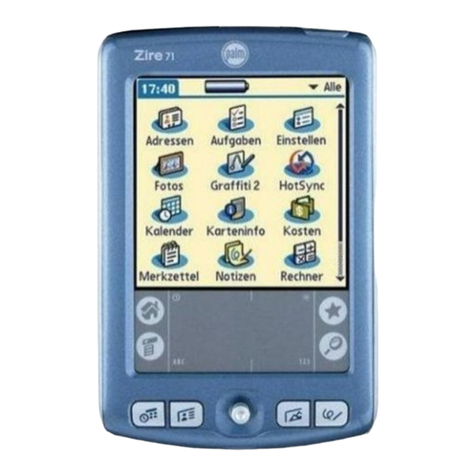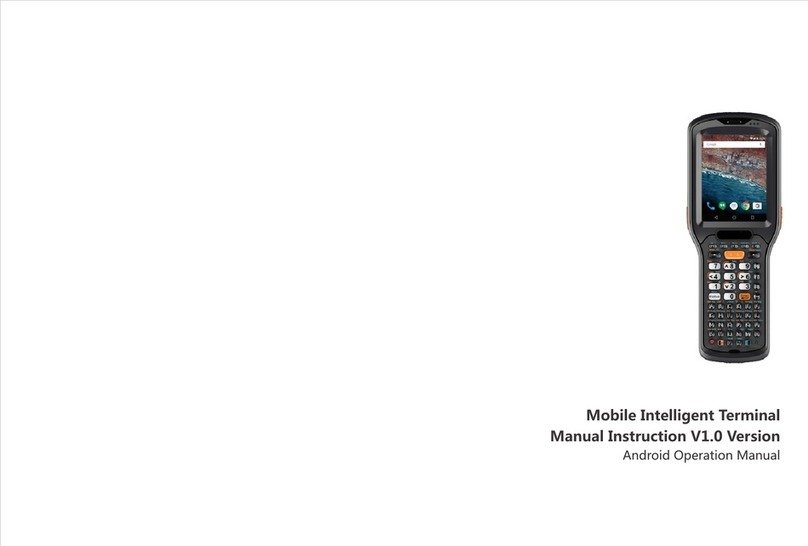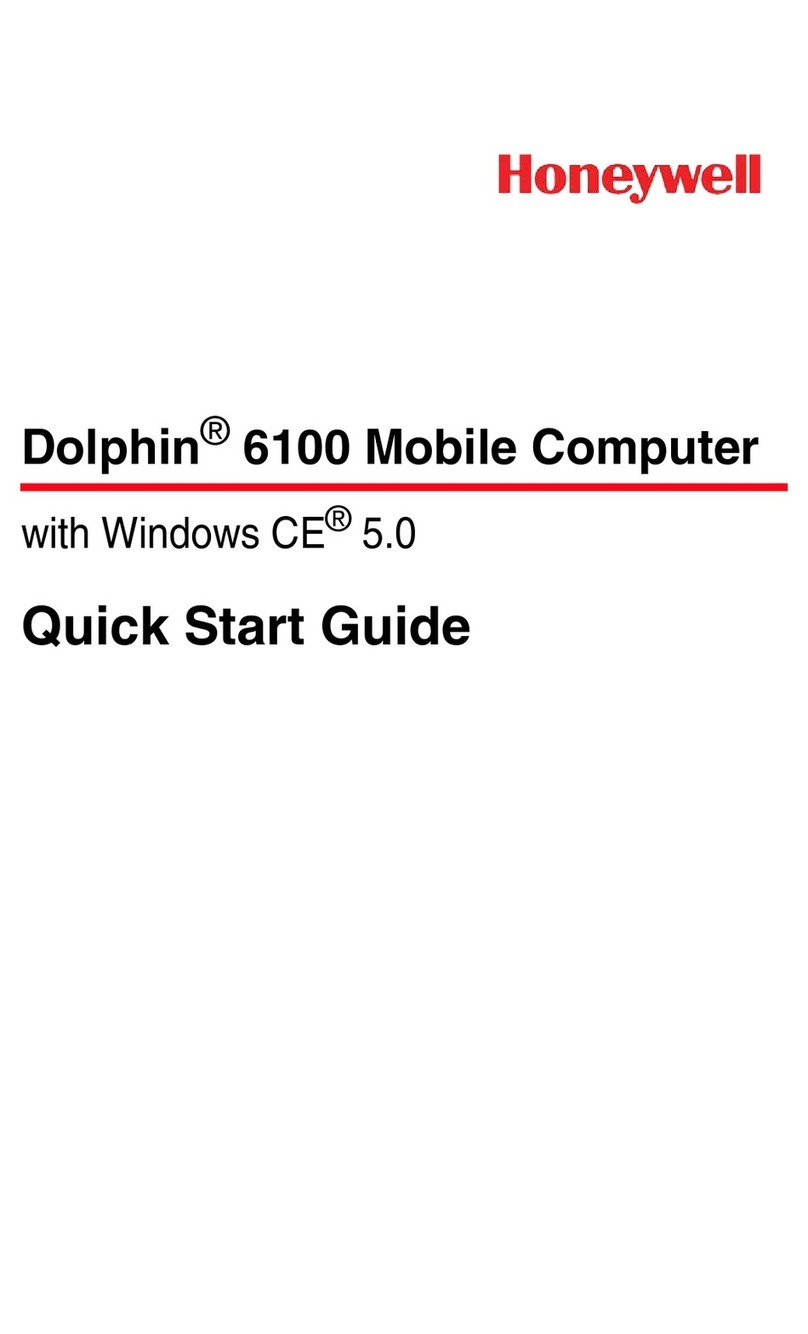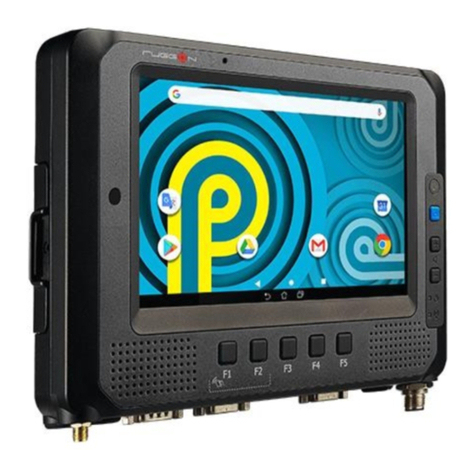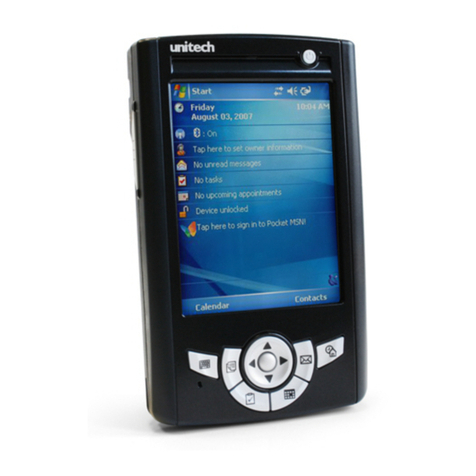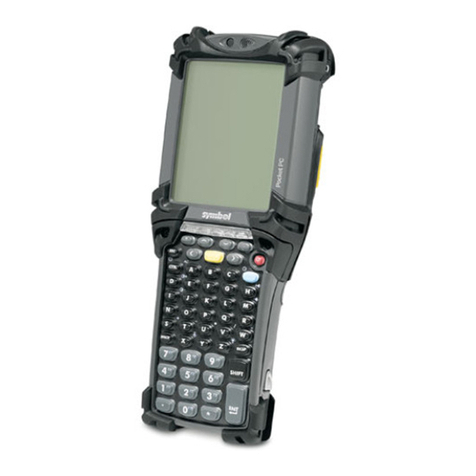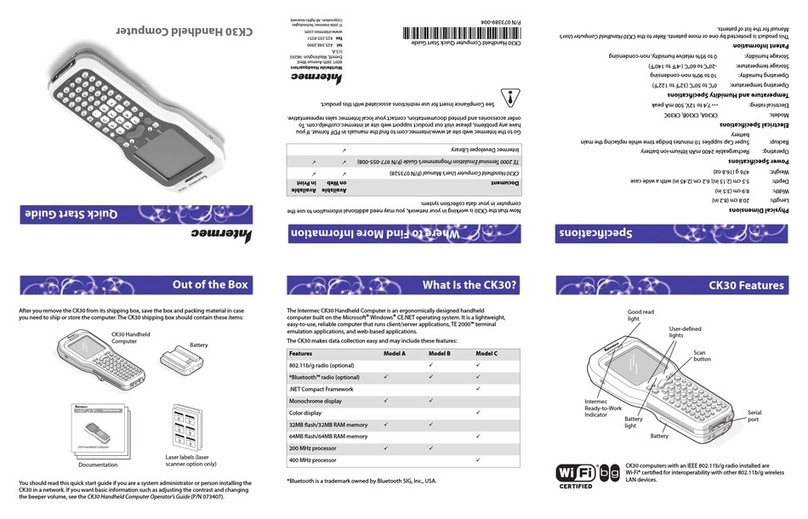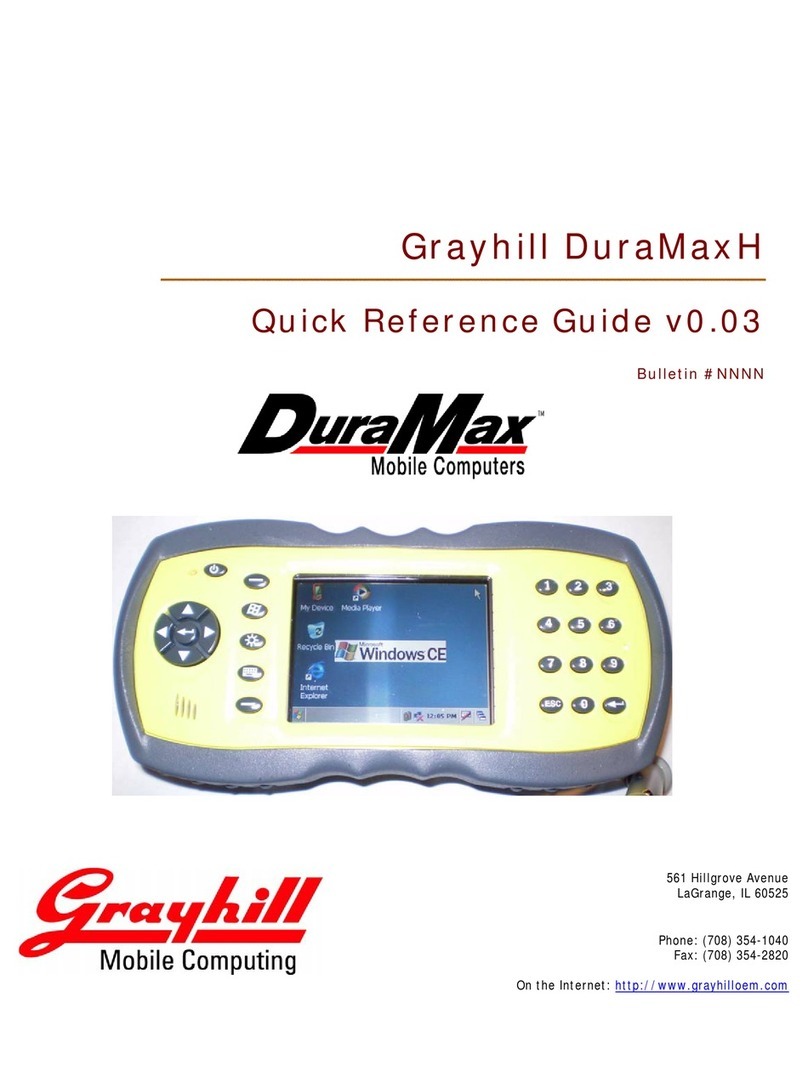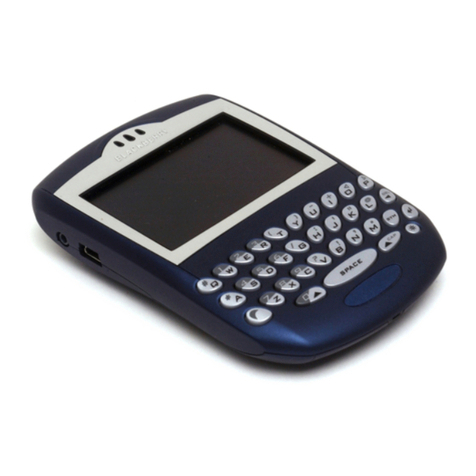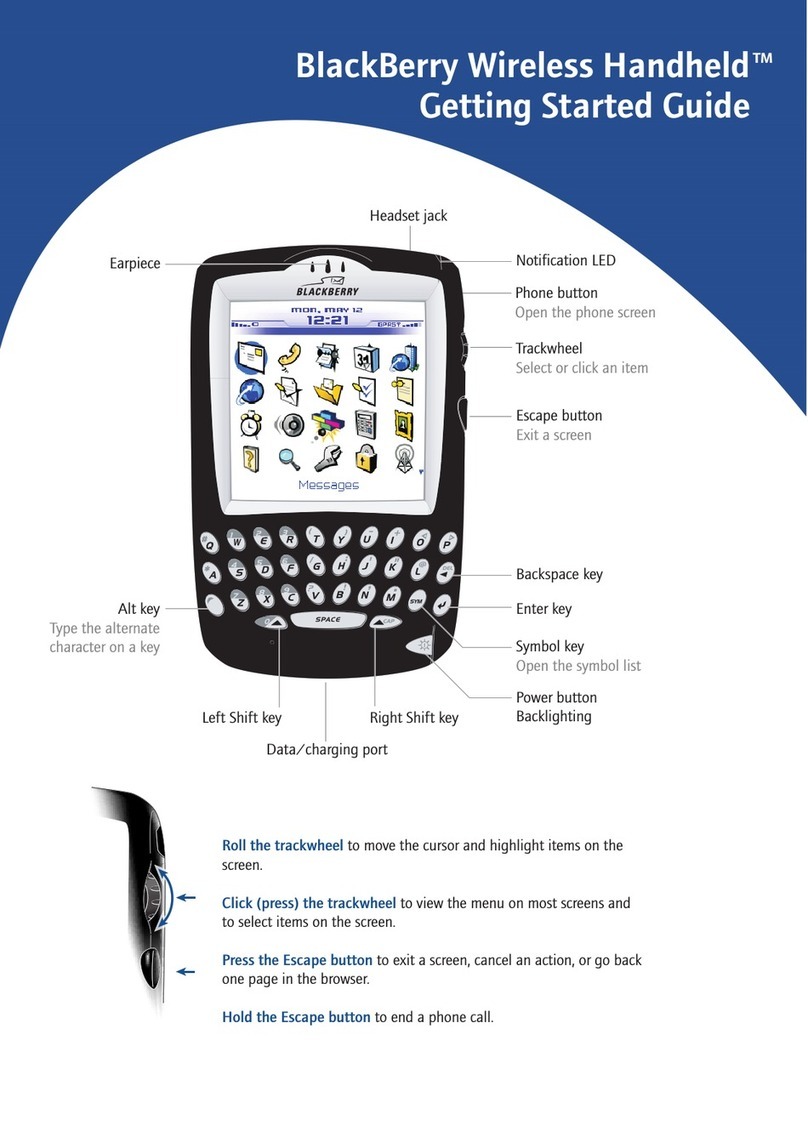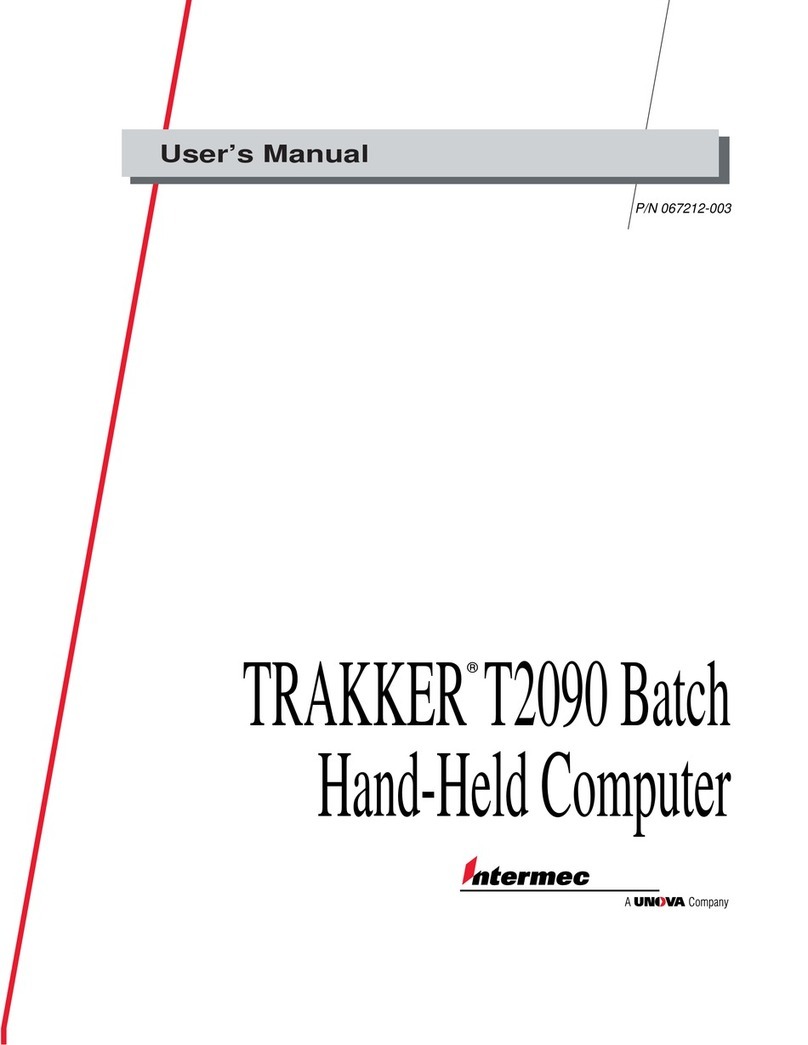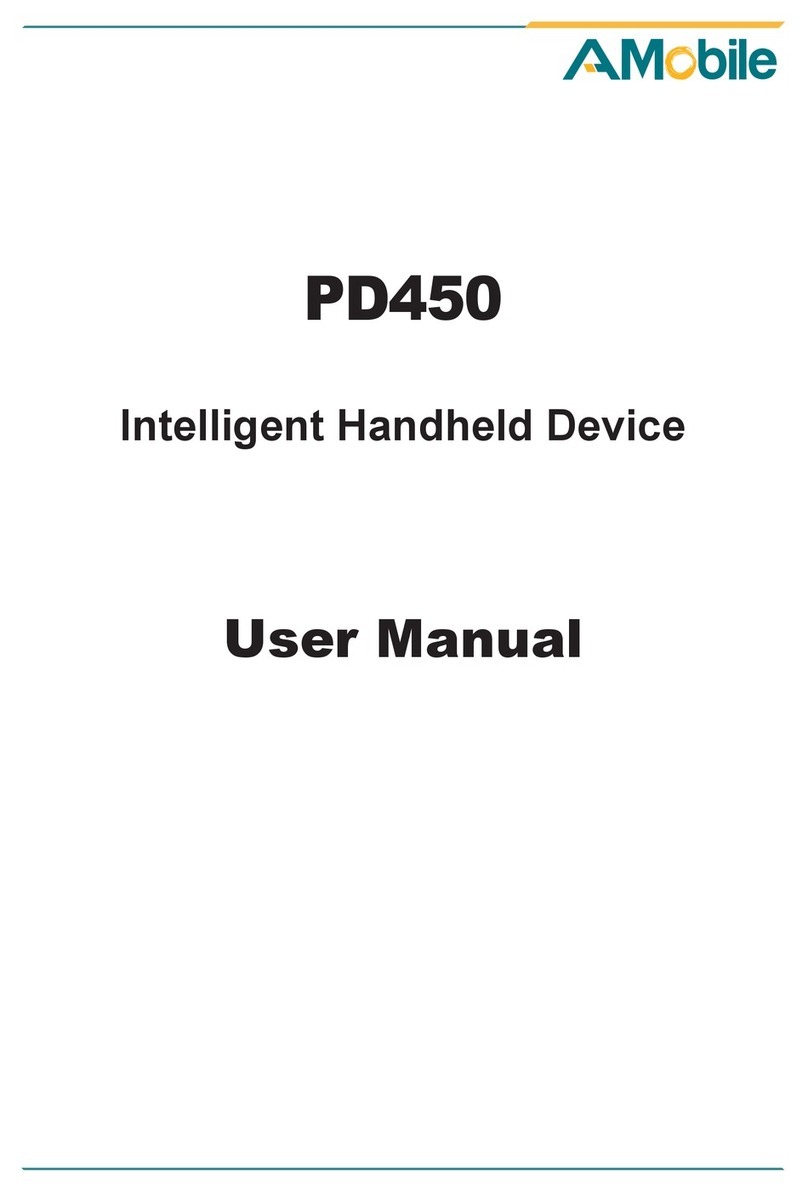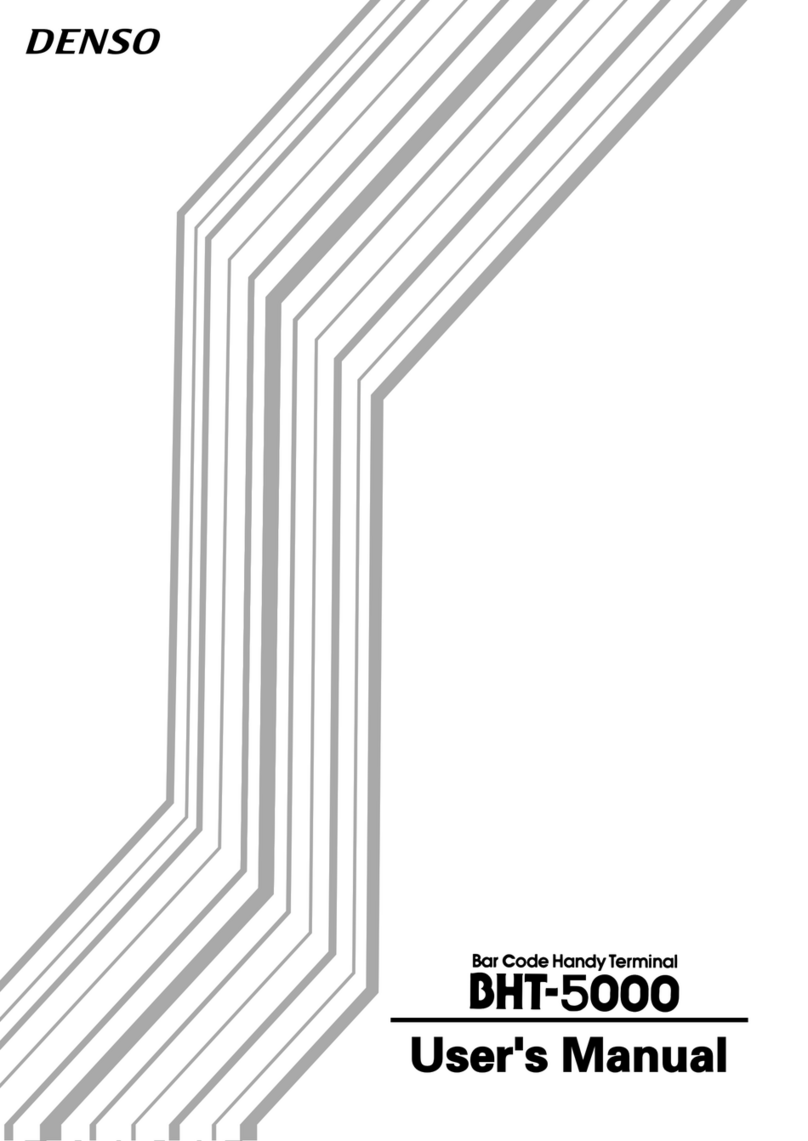Shin Chuan Computer SC800 User manual

SC800 / SC820 User’s Manual
WinCE. NET Rugged Portable Data Terminal
Mar/10/2008 Ver: 0.2

Table of Contents
Chapter 1.Introduction............................................................................ 1-1
1.1 About this Manual........................................................................... 1-1
1.2 User and Product Safety.................................................................. 1-2
1.3 Battery Safety.................................................................................. 1-3
1.4 CE Statement................................................................................... 1-4
1.5 FCC Statement ................................................................................ 1-8
1.6 Recycling & disposal instructions. ................................................. 1-9
1.7 Regulatory information................................................................... 1-9
1.8 Product Labeling........................................................................... 1-10
1.9 System Specifications ................................................................... 1-14
1.10 Environment Standard................................................................. 1-16
1.11 Warranty and after service........................................................... 1-16
Chapter 2.Getting Started........................................................................ 2-1
2.1 Check the package .......................................................................... 2-1
2.2 General View of the PDT................................................................ 2-3
2.2.1 SC800 general view ............................................................... 2-3
2.2.2 SC820 general view ............................................................... 2-5
2.3 Charging the Battery Pack .............................................................. 2-7
2.3.1 Installing the battery pack...................................................... 2-7
2.3.2 Charging the battery pack with Power Adapter ..................... 2-9
2.4. Handling the PDT ........................................................................ 2-10
2.4.1 Starting the PDT................................................................... 2-10
2.4.2 Power on / off....................................................................... 2-10
2.4.3 Calibration of the touch Screen.............................................2-11
2.4.4 To mute the Sound for SC800...............................................2-11
2.4.5 Adjusting the Sound for SC820 ............................................2-11
2.4.6 Using the Stylus ................................................................... 2-12
2.4.7 Using the SC800 Keypad..................................................... 2-12
2.4.8 Using the SC820 Keypad..................................................... 2-14
2.4.9 Using the Ear/Microphone................................................... 2-17
2.5 Navigating the Display ................................................................. 2-18
2.5.1 Setting Time and Date.......................................................... 2-18
2.5.2 Entering the Data ................................................................. 2-18
2.5.3 The Command Bar............................................................... 2-19

2.5.4 The Task Bar ........................................................................ 2-19
2.5.5 The Soft Keypad .................................................................. 2-20
2.5.6 Setting Up Wireless LAN .................................................... 2-20
2.5.7 Reading barcodes, 1D laser version..................................... 2-25
2.5.8 Help...................................................................................... 2-26
2.6 Power management....................................................................... 2-27
2.6.1 Suspend Mode...................................................................... 2-27
2.6.2 Resuming ............................................................................. 2-28
2.7 Resetting the PDT......................................................................... 2-28
2.7.1 Software (Warm) Reset........................................................ 2-28
2.7.2 Cold Reset............................................................................ 2-28
Chapter 3.Setting..................................................................................... 3-1
3.1 Introduction..................................................................................... 3-1
3.2 Control Panel .................................................................................. 3-1
3.2.1 BarCode Setting..................................................................... 3-2
3.2.2 Symbologies List ................................................................... 3-8
3.2.3 Bluetooth Device Properties ................................................ 3-24
3.2.4 Certificates ........................................................................... 3-28
3.2.5 Control Center...................................................................... 3-30
3.2.6 Date/Time............................................................................. 3-34
3.2.7 Dialing Properties ................................................................ 3-34
3.2.8 Display Properties................................................................ 3-36
3.2.9 Input Panel ........................................................................... 3-37
3.2.10 Internet Options ................................................................. 3-38
3.2.11 Keyboard............................................................................ 3-40
3.2.12 Network and Dial-up Connections..................................... 3-41
3.2.13 Owner................................................................................. 3-45
3.2.14 Password ............................................................................ 3-46
3.2.15 PC Connection ................................................................... 3-47
3.2.16 Power ................................................................................. 3-48
3.2.17 Regional Settings ............................................................... 3-50
3.2.18 Remove Programs.............................................................. 3-51
3.2.19 Storage Manager ................................................................ 3-52
3.2.20 Stylus.................................................................................. 3-53
3.2.21 System................................................................................ 3-54
3.2.22 Volume & Sounds Properties ............................................. 3-56
3.3 Taskbar and Start Menu ................................................................ 3-57

Chapter 4.Communication...................................................................... 4-1
4.1 Installing & Setting Up Microsoft ActiveSync............................... 4-1
4.1.1 Installing Microsoft ActiveSync on the Host PC................... 4-1
4.1.2 Connecting PDT to Host PC.................................................. 4-1
4.2 Using ActiveSync............................................................................ 4-1
4.2.1 Setting up a Partnership ......................................................... 4-1
4.2.2 ActiveSync File Synchronization........................................... 4-3
4.3 Networking ..................................................................................... 4-3
Chapter 5.Software Applications............................................................ 5-1
5.1 Introduction..................................................................................... 5-1
5.2 Software Applications..................................................................... 5-1
5.2.1 Inbox ...................................................................................... 5-1
5.2.2 Internet Explorer .................................................................. 5-10
5.2.3 Media Player ........................................................................ 5-13
5.2.4 Messenger ............................................................................ 5-13
5.2.5 Microsoft WordPad .............................................................. 5-13
5.2.6 Remote Connection.............................................................. 5-19
5.2.7 Windows Explorer ............................................................... 5-20
5.3 DiskOnChip .................................................................................. 5-22
5.3.1 Saving to Flash..................................................................... 5-22
5.3.2 DiskOnChip Location .......................................................... 5-22
5.3.3 DiskOnChip Size ................................................................. 5-23

1-1
Chapter 1.Introduction
Congratulations on purchasing the SC800/SC820 Portable Data Terminal (PDT), a
Microsoft Windows®CE .Net rugged PDT. Its special combination of features makes it
perfect for using in a wide range of applications. These features as:
Intel® XScaleTM PXA270 520MHz 32 bits RISC Processor
Windows® CE .NET 5.0 Operating System
128 MB SDRAM & 128 MB Flash ROM
Open Architecture: User Accessible SD Slot
240 x 320, 3.5” Color TFT Display with Touch Panel
One Numeric-Alpha Keyboards with LED backlight
802.11b/g Radio Support (Bluetooth Optional)
Integrated 1D Barcode Scanner
Changeable Keypad
1.1 About this Manual
The following chapters contained in this manual are:
Chapter 1: Introduction General information about the PDT.
Chapter 2: Getting started Describe the basic use of the PDT.
Chapter 3: Setting Provide basic instructions for customizing the
PDT.
Chapter 4: Communication Describe how to use all kinds of communication
of the PDT.
Chapter 5: Software Application Describe the installed applications on the PDT.

1-2
1.2 User and Product Safety
zDo not stare into the laser or LED beam directly or shine it into eyes.
zNever use strong pressure onto the screen or subject it to severe impact, as the
LCD panel could become cracked and possibility cause personal injury. If the
LCD panel is broken, never touch the liquid inside because the liquid irritates the
skin.
zAlthough the PDT has passed the test of IP65 standard for water and dust
resistance, avoid prolonged exposure to rain or other concentrated moisture.
Such condition exceeds the IP65 standard, and could result in water or other
contaminants entering into the PDT.
zUse only the original approved AC Adapter with the PDT. Use of an unapproved
AC Adapter could result in electrical problems, or even cause a fire or electrical
shock to the user.
zDo not disassemble the PDT. Servicing should be done by supplier only. If the
PDT or accessories gets damaged due to wrong handling or unauthorized repair,
warranty is void. In case the warranty seals are broken, warranty is void too.
zMake regularly back-ups of all important data.
zUnder no circumstance will supplier be liable for any direct, indirect,
consequential or incidental damages baring out of the use or inability to use the
hardware and software and/or any data loss, even if supplier has been informed
about the possibility of such damages.
zLASER RADIATION DO NOT STARE INTO BEAM CLASS 2 LASER
PRODUCT

1-3
1.3 Battery Safety
CAUTION: Risk of Explosion if Battery is replaced by an Incorrect Type. Dispose of
Used Batteries According to the Instructions.
Lithium-ion battery packs might get hot, explode, ignite and/or cause serious injury if
exploded by abusive using. Please follow the safety warnings listed as below:
zDo not throw the battery pack in fire. Do not expose the battery to high
temperatures.
zDo not connect the positive battery pack with negative battery pack to each other
with any metal object (like wire).
zDo not carry or store battery pack together with metal objects.
zDo not pierce the battery pack with nails or drills, strike the battery pack with a
hammer, step on the battery pack or otherwise expose it to strong impacts,
shocks or excessive force.
zDo not solder onto the battery pack.
zDo not expose battery pack to liquid or allow the battery contacts to get wet.
zDo not disassemble or modify the battery pack. The battery pack contains safety
and protection measures, which, if damaged, may cause the battery pack to
generate heat, explode or ignite.
zDo not discharge the battery pack using any device except for the specified
device. When it is used in devices other than the specified devices, the battery
pack can be damaged or its life expectancy reduced. If the device causes any
abnormal current to flow, it may cause the battery pack to become hot, explode
or ignite and cause serious injury.
zIn the event the battery pack leaks and the fluid gets into one’s eye, do not rub
the eye. Rinse well with water and immediately seek medical care. If left
untreated, the battery fluid could cause damage to the eye.

1-4
1.4 CE Statement
Europe – EU Declaration of Conformity
This device complies with the essential requirements of the R&TTE Directive
1999/5/EC. The following test methods have been applied in order to prove
presumption of conformity with the essential requirements of the R&TTE Directive
1999/5/EC:
-EN 60950-1: 2006
Safety of Information Technology Equipment
-EN50360 : (2001-07)
-Product standard to demonstrate the compliance of mobile phones with the basic
restrictions related to human exposure to electromagnetic fields (300 MHz-3GHz)
-EN50361 : (2001-07)
-Basic standard for the measurement of specific absorption rate related to human
exposure to electromagnetic fields from mobile phones (300 MHz-3 GHz)
-
-EN50371 : (2002-03)
-Generic standard to demonstrate the compliance of low power electronic and
electrical apparatus with the basic restrictions related to human exposure to
electromagnetic fields (10 MHz-300 GHz) -- General public
-EN 300 328 V1.7.1: (2006-10)
-Electromagnetic compatibility and Radio spectrum Matters (ERM); Wideband
Transmission systems; Data transmission equipment operating in the 2,4 GHz
ISM band and using spread spectrum modulation techniques; Harmonized EN
covering essential requirements under article 3.2 of the R&TTE Directive
-EN 301 511 V9.0.2: (2003-03)
-Global System for Mobile communications (GSM); Harmonized standard for
mobile stations in the GSM 900 and DCS 1800 bands covering essential
requirements under article 3.2 of the R&TTE directive (1999/5/EC)
-EN 301 489-1 V1.6.1: (2005-09)

1-5
-Electromagnetic compatibility and Radio Spectrum Matters (ERM);
ElectroMagnetic Compatibility (EMC) standard for radio equipment and services;
Part 1: Common technical requirements
-EN 301 489-17 V1.2.1 (2002-08)
-Electromagnetic compatibility and Radio spectrum Matters (ERM);
ElectroMagnetic Compatibility (EMC) standard for radio equipment and services;
Part 17: Specific conditions for 2,4 GHz wideband transmission systems and 5
GHz high performance RLAN equipment
-EN 301 489-7 V1.2.1: (2002-08)
ElectroMagnetic compatibility and Radio spectrum Matters (ERM);
ElectroMagnetic Compatibility (EMC) standard for radio equipment ad services;
Part 7: Specific conditions for mobile and portable radio and ancillary equipment
of digital cellular radio telecommunications systems (GSM and DCS)
This device is a 2.4 GHz wideband transmission system (transceiver), intended for use
in all EU member states and EFTA countries, except in France and Italy where
restrictive use applies.
In Italy the end-user should apply for a license at the national spectrum authorities in
order to obtain authorization to use the device for setting up outdoor radio links and/or
for supplying public access to telecommunications and/or network services.
This device may not be used for setting up outdoor radio links in France and in some
areas the RF output power may be limited to 10 mW EIRP in the frequency range of
2454 – 2483.5 MHz. For detailed information the end-user should contact the national
spectrum authority in France.
0560
Česky
[Czech]
[Jméno výrobce] tímto prohlašuje, že tento [typ zařízení] je ve shoděse
základními požadavky a dalšími příslušnými ustanoveními směrnice
1999/5/ES.
Dansk
[Danish]
Undertegnede [fabrikantens navn] erklærer herved, at følgende udstyr
[udstyrets typebetegnelse] overholder de væsentlige krav og øvrige
relevante krav i direktiv 1999/5/EF.

1-6
Deutsch
[German]
Hiermit erklärt [Name des Herstellers], dass sich das Gerät [Gerätetyp]
in Übereinstimmung mit den grundlegenden Anforderungen und den
übrigen einschlägigen Bestimmungen der Richtlinie 1999/5/EG befindet.
Eesti
[Estonian]
Käesolevaga kinnitab [tootja nimi = name of manufacturer] seadme
[seadme tüüp = type of equipment] vastavust direktiivi 1999/5/EÜ
põhinõuetele ja nimetatud direktiivist tulenevatele teistele asjakohastele
sätetele.
English Hereby, [name of manufacturer], declares that this [type of equipment] is
in compliance with the essential requirements and other relevant
provisions of Directive 1999/5/EC.
Español
[Spanish]
Por medio de la presente [nombre del fabricante] declara que el [clase de
equipo] cumple con los requisitos esenciales y cualesquiera otras
disposiciones aplicables o exigibles de la Directiva 1999/5/CE.
Ελληνική
[Greek]
ΜΕ ΤΗΝ ΠΑΡΟΥΣΑ [name of manufacturer] ΔΗΛΩΝΕΙ ΟΤΙ [type of
equipment] ΣΥΜΜΟΡΦΩΝΕΤΑΙ ΠΡΟΣ ΤΙΣ ΟΥΣΙΩΔΕΙΣ
ΑΠΑΙΤΗΣΕΙΣ ΚΑΙ ΤΙΣ ΛΟΙΠΕΣ ΣΧΕΤΙΚΕΣ ΔΙΑΤΑΞΕΙΣ ΤΗΣ
ΟΔΗΓΙΑΣ 1999/5/ΕΚ.
Français
[French]
Par la présente [nom du fabricant] déclare que l'appareil [type
d'appareil] est conforme aux exigences essentielles et aux autres
dispositions pertinentes de la directive 1999/5/CE.
Italiano
[Italian]
Con la presente [nome del costruttore] dichiara che questo [tipo di
apparecchio] è conforme ai requisiti essenziali ed alle altre disposizioni
pertinenti stabilite dalla direttiva 1999/5/CE.
Latviski
[Latvian]
Ar šo [name of manufacturer / izgatavotāja nosaukums] deklarē, ka
[type of equipment / iekārtas tips] atbilst Direktīvas 1999/5/EK
būtiskajām prasībām un citiem ar to saistītajiem noteikumiem.
Lietuvių
[Lithuanian]
Šiuo [manufacturer name] deklaruoja, kad šis [equipment type] atitinka
esminius reikalavimus ir kitas 1999/5/EB Direktyvos nuostatas.
Nederlands
[Dutch]
Hierbij verklaart [naam van de fabrikant] dat het toestel [type van
toestel] in overeenstemming is met de essentiële eisen en de andere
relevante bepalingen van richtlijn 1999/5/EG.
Malti
[Maltese]
Hawnhekk, [isem tal-manifattur], jiddikjara li dan [il-mudel tal-prodott]
jikkonforma mal-ħtiġijiet essenzjali u ma provvedimenti oħrajn relevanti
li hemm fid-Dirrettiva 1999/5/EC.
Magyar
[Hungarian]
Alulírott, [gyártó neve] nyilatkozom, hogy a [... típus] megfelel a
vonatkozó alapvetõ követelményeknek és az 1999/5/EC irányelv egyéb

1-7
elõírásainak.
Polski
[Polish]
Niniejszym [nazwa producenta] oświadcza, że [nazwa wyrobu] jest
zgodny z zasadniczymi wymogami oraz pozostałymi stosownymi
postanowieniami Dyrektywy 1999/5/EC.
Português
[Portuguese]
[Nome do fabricante] declara que este [tipo de equipamento] está
conforme com os requisitos essenciais e outras disposições da Directiva
1999/5/CE.
Slovensko
[Slovenian]
[Ime proizvajalca] izjavlja, da je ta [tip opreme] v skladu z bistvenimi
zahtevami in ostalimi relevantnimi določili direktive 1999/5/ES.
Slovensky
[Slovak]
[Meno výrobcu] týmto vyhlasuje, že [typ zariadenia] spĺňa základné
požiadavky a všetky príslušné ustanovenia Smernice 1999/5/ES.
Suomi
[Finnish]
[Valmistaja = manufacturer] vakuuttaa täten että [type of equipment =
laitteen tyyppimerkintä] tyyppinen laite on direktiivin 1999/5/EY
oleellisten vaatimusten ja sitä koskevien direktiivin muiden ehtojen
mukainen.
Svenska
[Swedish]
Härmed intygar [företag] att denna [utrustningstyp] står I
överensstämmelse med de väsentliga egenskapskrav och övriga relevanta
bestämmelser som framgår av direktiv 1999/5/EG.

1-8
1.5 FCC Statement
Federal Communication Commission Interference Statement
This equipment has been tested and found to comply with the limits for a Class B
digital device, pursuant to Part 15 of the FCC Rules. These limits are designed to
provide reasonable protection against harmful interference in a residential installation.
This equipment generates uses and can radiate radio frequency energy and, if not
installed and used in accordance with the instructions, may cause harmful interference
to radio communications. However, there is no guarantee that interference will not
occur in a particular installation. If this equipment does cause harmful interference
to radio or television reception, which can be determined by turning the equipment off
and on, the user is encouraged to try to correct the interference by one of the
following measures:
-Reorient or relocate the receiving antenna.
-Increase the separation between the equipment and receiver.
-Connect the equipment into an outlet on a circuit different from that to which
the receiver is connected.
-Consult the dealer or an experienced radio/TV technician for help.
FCC Caution: Any changes or modifications not expressly approved by the party
responsible for compliance could void the user's authority to operate this equipment.
This device complies with Part 15 of the FCC Rules. Operation is subject to the
following two conditions: (1) This device may not cause harmful interference, and (2)
this device must accept any interference received, including interference that may
cause undesired operation. Complies with 21 CFR 1040.10 and 1040.11 except for
deviations pursuant to Laser Notice No. 50, dated June 24, 2007.
IMPORTANT NOTE:
Radiation Exposure Statement:
This equipment complies with FCC radiation exposure limits set forth for an
uncontrolled environment. End users must follow the specific operating instructions
for satisfying RF exposure compliance. To maintain compliance with FCC RF
exposure compliance requirements, please follow operation instruction as documented
in this manual.
This transmitter must not be co-located or operating in conjunction with any other
antenna or transmitter.
The availability of some specific channels and/or operational frequency bands are

1-9
country dependent and are firmware programmed at the factory to match the intended
destination. The firmware setting is not accessible by the end user.
Caution: SCC declares that SC800 ( FCC ID: TQ2-SC800PDT-BW ) / SC820
( FCC ID: TQ2-SC800PDT-BW ) is limited in CH1~CH11 for 2.4GHz by
specified firmware controlled in U.S.A.
The FCC ID of SC800/SC820 is TQ2-SC800PDT-BW
LED AND LASER SAFETY INFORMATION
zClass II LED/Laser Product
zDo not stare at the LED/Laser or shine into eyes
zDo not allow young children to use the product without adult supervision
zDo not replace/repair the LED/Laser, these are not user replaceable
zDo not shine the LED/Laser on a shiny reflective surface
zLASER RADIATION DO NOT STARE INTO BEAM CLASS 2 LASER
PRODUCT
1.6 Recycling & disposal instructions.
Do not throw this product in the home waste bin. For proper end-of-life
treatment consult the
Environmental care section of ftp://ftp.sccltd.com.tw/
1.7 Regulatory information.
For CE, FCC, RoHS and other Document of Conformities, consult the
Regulatory section of ftp://ftp.sccltd.com.tw

1-10
1.8 Product Labeling
The PDT has several labels as showed in Figure 1-1 to 1-4.
A. SC800
Figure 1-1 Product Labeling (Front side view)
Label nr. Description
1 LCD panel protection film
2 SC800 logo
3 Warranty seal PDT
Table 1-1 Front labeling

1-11
Figure 1-2 Product Labeling (Back side view)
Label nr. Description
4 Laser radiation warning label
5 Serial / Configuration number
6 PenPower label (only use on Simplified
Chinese version)
7 CCC label (only use with China)
8 System and regulatory label
9 NCC label (only use on Traditional Chinese
version)
10 RoHS Use Life Label for China
11 Windows CE .NET label
Table 1-2 Rear labeling

1-12
B. SC820
Figure 1-3 Product Labeling (Front side view)
Label nr. Description
1 LCD panel protection film
2 SC820 logo
3 Warranty seal PDT
Table 1-3 Front labeling

1-13
Figure 1-4 Product Labeling (Back side view)
Label nr. Description
4 LED/Laser radiation warning label
5 Serial / Configuration number
6 PenPower label (only use on Simplified
Chinese version)
7 CCC label (only use with China)
8 System and regulatory label
9 NCC label (only use on Traditional Chinese
version)
10 RoHS Use Life Label for China
11 Windows CE .NET label
Table 1-4 Rear labeling

1-14
1.9 System Specifications
The SC800 / SC820 detailed specifications as follows. Unless otherwise noted, all the
specifications are subject to change without prior notification.
Table 1-5 System Specification
SC800 / SC820
Processor - Intel PXA270 520MHz 32 bits RISC CPU
Memory - 128MB Flash ROM
- 128MB SDRAM
Display - 240 x 320 3.5” TFT 256K Color LCD with LED
backlight
Audio
- One mono speaker for system voice (on lower case)
- One 2.5 mm Ø stereo earphone jack with mono mike
input
- One internal MIC
- One Receiver
Expansion Slot - One SD/MMC slot (only support SD memory)
- One SIM slot for WAN module
LED - One Dual-Color LED for Charger Indicator
- One Dual-Color LED for Scanner Indicator
Radio Support
- Wireless LAN: 802.11b/g
- Bluetooth: Class II
- IrDA: 1.2
Scan Engine - Symbol, Opticon Laser (1D) Engine. (optional)
Communication Ports
- USB: Support USB v1.1 both host and client.
(PDT and Cradle)
- Serial: RS232 via optional cable or Cradle.
Power System
- Standard Li-Ion Battery Pack, 3.7V, 2200mAh
- Advanced Smart Battery with Gas-Gauge
- Built-in Battery Charger
- 4.2V/70mAh rechargeable backup battery
- One Battery Cover Sensor Switch
- Power Adapter: 100~240V AC, 50/60Hz Input ;
5VDC/2.6A Output

1-15
SC800 / SC820
SC800
- One Power Button
- One Reset Button
- Three Barcode Scanner Buttons
- Two Navigation Buttons
- Four Application Buttons
- One 18-key Numeric Keypad
- One Reserved Button
Keypad / Buttons
SC820
- One Power Button
- One Reset Button
- Three Barcode Scanner Buttons
- Two Navigation Buttons
- Four Application Buttons
- One 33-key Alpha-Numeric Keypad
- One Reserved Button
Dimensions and
Weight
- Dimensions:
L: 155mm, W: 82mm, H: 31~33mm
- Weight: 400g with Standard Battery Pack
Color - Black
Peripherals and
Accessories
- Optional: RS232 Serial Cable for Terminal / USB
Host Cable for Terminal / High-Capacity Li-Ion
Battery Pack (3.7V, 4000 mAh) / Single Dock / 4 Slot
Battery Charger / Car Adapter / RS232 Cable / Pistol
Grip
Software - Microsoft Windows CE.NET 5.0 Professional

1-16
1.10 Environment Standard
Table 1-6 Environment Standards
Operating Temperature 14oF ~ 122oF( -10oC ~ 50oC)
Storage Temperature -4oF ~ 158oF (-20oC ~ 60oC)
Humidity 5% ~ 95% (non-condensing)
Drop 5ft (1.5m) Drop onto Concrete
Water & Dust proof IP65 Certificated
Vibration MIL STD 810F
1.11 Warranty and after service
Should this PDT be malfunctioned, please contact your original retailer providing
information about the product name, the serial number, and the details about the
problem.
Other manuals for SC800
1
This manual suits for next models
1
Table of contents
